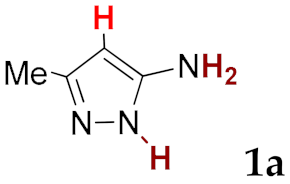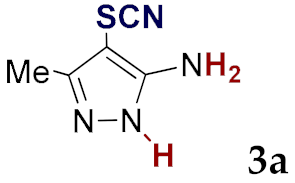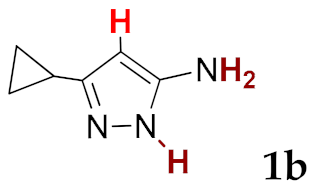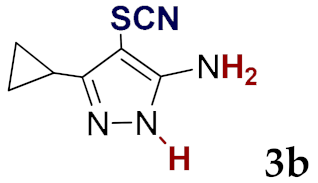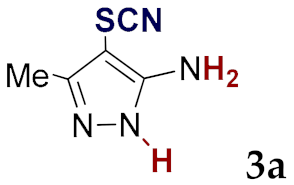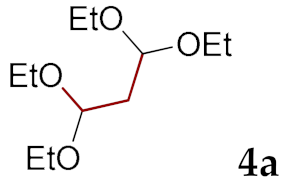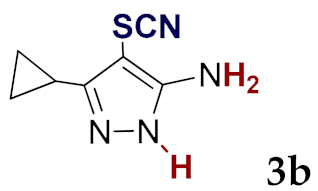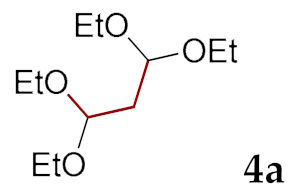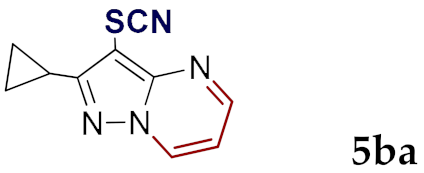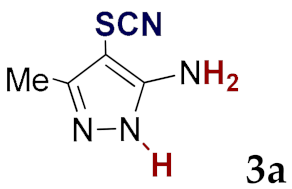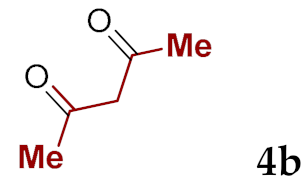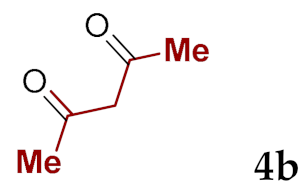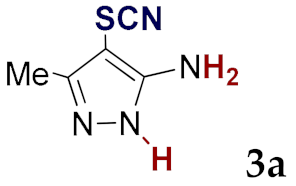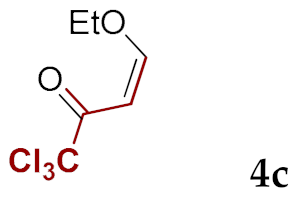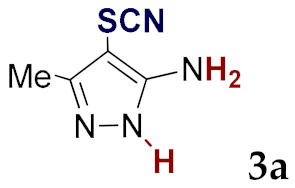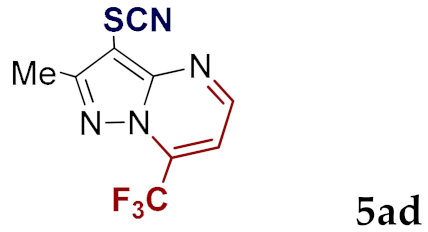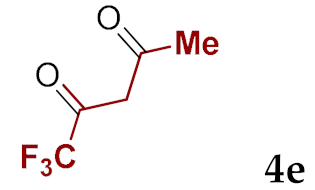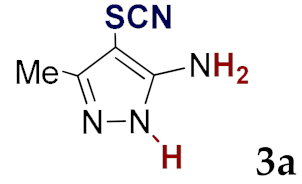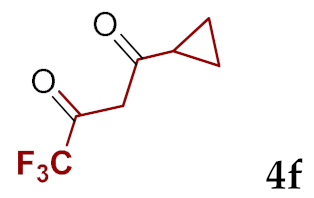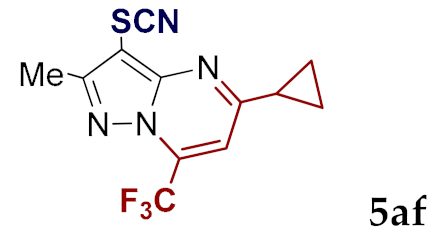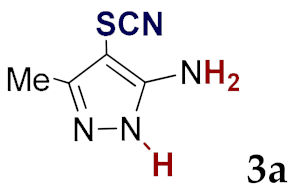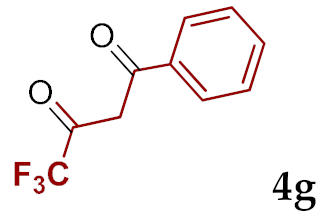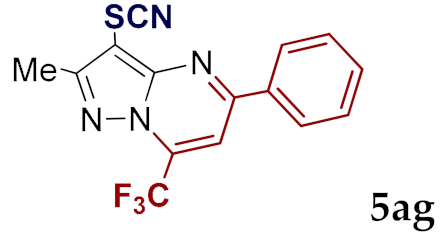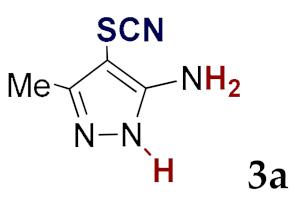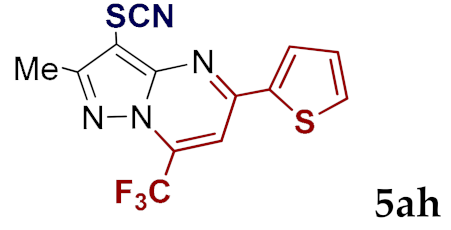Abstract
In this article, we demonstrate how an original effective “metal-free” and “chromatography-free” route for the synthesis of 3-thiocyanatopyrazolo[1,5-a]pyrimidines has been developed. It is based on electrooxidative (anodic) C–H thiocyanation of 5-aminopyrazoles by thiocyanate ion leading to 4-thiocyanato-5-aminopyrazoles (stage 1, yields up to 87%) following by their chemical condensation with 1,3-dicarbonyl compounds or their derivatives (stage 2, yields up to 96%). This method is equally effective for the synthesis of 3-thiocyanatopyrazolo[1,5-a]pyrimidines, both without substituents and with various donor (acceptor) substituents in the pyrimidine ring.
1. Introduction
The functionalization of arenes ensures their diversity and opens the way to a wide range of practically useful substances. At present, the important methodology for (hetero)arenes modification is the functionalization of their C–H bonds [1,2,3]. One of the actively developed approaches is the electrooxidative C–H functionalization of (hetero)arenes, using the anode (An) as a “green oxidizing agent” (C–H (An) functionalization) [4,5,6,7].
Our attention was attracted by C–H thiocyanation of (hetero)arenes, which is usually carried out chemically [8,9]. Resulting (hetero)aryl thiocyanates are interesting as precursors of various sulfur-containing compounds, as well as substances with a wide spectrum of bioactivity [8,9,10,11,12,13].
Earlier, we realized several processes of anodic C–H thiocyanation of (hetero)arenes [14,15,16,17,18] as part of the development of the C–H (An) functionalization methodology. To obtain target products, a thiocyanate ion (I)/(hetero)arene (II) mixture in MeCN was subjected to controlled potential electrolysis (CPE) at an anode potential (ЕAn) equal to the oxidation peak potential (Epox) of SCN− (Scheme 1) in an undivided cell equipped with Pt or glassy carbon (GC) electrodes. Based on cyclic voltammetry (CV) data and depending on conditions, the ЕAn was 0.70–0.85 V (vs. SCE). Furthermore, that C–H (An) thiocyanation can be carried out at galvanostatic electrolysis (GE) [14,16,19,20,21].

Scheme 1.
C–H (An) thiocyanation of (hetero)arenes (II) via the thiocyanogen (I′) at controlled potential electrolysis (CPE) at ЕAn = EpoxSCN−.
The key intermediate of such processes is well-known [8,9] thiocyanogen (I′), which is electrogenerated at stage I → I′. In addition to interaction with arene II, leading to aryl thiocyanate III (stage (I′ + II → III), thiocyanogen I′ is capable of polymerization to polythiocyanogen IV (stage I′ → IV) [14,16,22].
To avoid polymerization, electrolysis can be carried out at low current densities for 1–3 days [21] or at low temperatures [23]. However, we found [14] that thiocyanation in MeCN is successfully realized even at room temperature for 2–4 h—probably due to the ability of MeCN to partially stabilize thiocyanogen I′ [16].
On the other hand, it was shown [16,17,18] that CPE of an SCN− (I)/(hetero)arene (II) mixture can be realized at EAn = Epox(Неt)ArH (Scheme 2). The process can proceed according to the ECE mechanism [16,18] via the electrogeneration of the radical cation II′, leading to the target product III in good yield. This is especially valuable when the previous process (Scheme 1) was ineffective.

Scheme 2.
C–H (An) thiocyanation of (hetero)arenes (II) via ECE mechanism at CPE at EAn = Epox(Неt)ArH.
A similar situation was reported in refs [16,18], where several approaches to the efficient C–H (An) thiocyanation of substituted pyrazolo[1,5-a]pyrimidines were first developed. Such structures are of big interest, because pyrazolo[1,5-a]pyrimidine is one of the synthetic analogs of purine and a scaffold for many bioactive compounds [24]. During the above studies, initial pyrazolo[1,5-a]pyrimidines were preliminarily obtained by condensation of 5-aminopyrazoles with 1,3-dicarbonyl compounds (or their derivatives) under various conditions [15,25,26,27,28,29,30] with very moderate yields in half the cases. On the contrary, C–H (An) thiocyanation of pyrazolo[1,5-a]pyrimidines was implemented in good and high yields in all cases [15,16,18].
Considering the above, we expected more efficiency from the new approach (Scheme 3), where stage 1 corresponds to C–H (An) thiocyanation of 5-aminopyrazole 1 leading to pyrazole 3; and stage 2 corresponds to the condensation of pyrazole 3 with a 1,3-dicarbonyl compound (or its derivative) 4 to form the target product 5. In addition, the condensation of 4-substituted aminopyrazoles usually proceeds in high yields [31,32,33].

Scheme 3.
A new approach to the synthesis of 3-thiocyanatopyrazolo[1,5-a]pyrimidines 5: C–H (An) thiocyanation of 5-aminopyrazoles 1 (stage 1) following by condensation of the resulting 4-thiocyanatopyrazoles 3 with a 1,3-dicarbonyl compounds (or their derivatives) 4 (stage 2).
Thus, the ultimate goal of the present work was to assess the feasibility and efficiency of the new approach to the synthesis of 3-thiocyanatopyrazolo[1,5-a]pyrimidines (Scheme 3).
2. Results and Discussion
2.1. Anodic C–H Thiocyanation of 5-Aminopyrazoles (Scheme 3, Stage 1)
Predicting successful C–H (An) thiocyanation of various (hetero)arenes is of obvious interest. We have recently developed the original express-test to find suitable (hetero)arenes for such processes and to evaluate their efficiency without electrolysis [34]. This test is based on an analysis of CV data for thiocyanate ion, (hetero)arenes and their mixtures. Thus, we started the study of stage 1 (Scheme 3) with CV measurements (Figure 1).
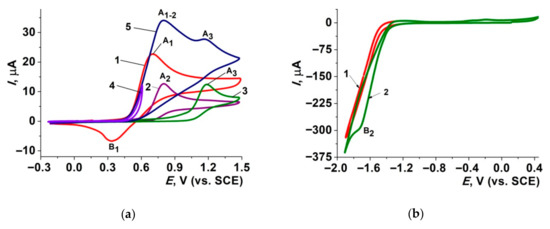
Figure 1.
Cyclic voltammetry (CV) curves on Pt working electrode in 0.1M NaClO4 in MeCN, ν = 0.10 V·s−1. (a) NH4SCN (0.002 М)—1; azole 1а (0.002 М)—2; 3-methyl-4-thiocyanato-1H-pyrazol-5-amine 3a (0.002 М)—3; mixture NH4SCN/azole 1а (1:1) with the reverse scan from 0.60 V—4; the same on the reverse scan from 1.45 V—5; (b) azole 1а (0.002 М)—1; thiocyanato-pyrazole 3a (0.002 М)—2.
2.1.1. CV Data
The model object was the couple thiocyanate ion/3-methyl-1H-pyrazol-5-amine (1a) (previously not studied in either the electrochemical or chemical C–H thiocyanation). Figure 1a shows a typical CV of the SCN− ion (curve 1) with a one-electron oxidation peak A1 (Epox = 0.70 V). Its irreversibility is due to the formation of thiocyanogen I′ (see Scheme 1, stage I→I′), which was observed on the reverse scan as the reduction peak B1 (Epred = 0.34 V) [14,16,23,34]. The changes in peak B1 after adding of (hetero)arene to the thiocyanate ion solution is the basis of the above express-test: If the peak B1 did not change, then (hetero)arene does not react with thiocyanogen I′, whereas if the peak B1 decreased or disappeared, then the (hetero)arene reacts with thiocyanogen I′ (see stage I′ + II → III). Moreover, the more efficient the target process, the lower the peak B1 height.
As follows from Figure 1a, the adding of an equimolar amount of azole 1а led to a complete disappearance of peak B1 even at a potential reverse from 0.60 V (curve 4). It means almost complete consumption of thiocyanogen I′, due to its rapid interaction with azole 1a. At the same time, peak B1 also disappeared when the potential was reversed from 1.45 V (curve 5). This case is primarily interesting because the peak A1–2 (Epox = 0.80 V, curve 5) is obviously the peak of the co-oxidation of the SCN ̶ (Epox = 0.70 V, see curve 1) and azole 1а (Epox = 0.81 V, see curve 2), since the ΔEpox of these peaks is 0.11 V.
These results indicate the effective interaction of thiocyanogen and azole 1a, according to Scheme 1 (stage I′+ II → III). At the same time, the nearness of the oxidation potentials of thiocyanate ion and azole 1a (0.11 V) does not exclude the ECE mechanism (Scheme 2), especially since the anodic oxidation of azole 1a cannot be excluded even at 0.70 V. Overall, the set of CV data indicates the probability of successful realization of C–H (An) thiocyanation. It was also confirmed by peak A3 (Epox = 1.15 V, curve 5), which corresponds to the oxidation of target product 3а (cf. with curve 3). Note that 3-cyclopropyl-1H-pyrazol-5-amine (1b) (an additional research object) had similar CV behavior.
It must be pointed that the C–H (An) thiocyanation of (hetero)arenes is often performed in undivided cells, neglecting the possible cathodic decomposition of the target products, which can affect the processes efficiency. Therefore, we accomplished additional CV studies to evaluate this possibility. Figure 1b shows that the CV curve of the initial azole 1a in the cathodic region (curve 1) practically coincided with that of the supporting electrolyte, while thiocyanato-pyrazole 3a gave the clear reduction peak (Epred = –1.72 V, curve 2). Taking into account these results, the electrolysis in a divided cell seemed to be more appropriate, since it excluded the possible reduction and, accordingly, decomposition of the target thiocyanato-product.
2.1.2. Effect of Electrolysis Conditions on the Yield of the Target Product
On the example of electrolysis of a thiocyanate ion/azole 1a mixture, it turned out that process proceeded most efficiently on GC electrodes (which were also effective in thiocyanation of other (hetero)arenes [16,18]) than on commonly used Pt electrodes (Table 1, cf. entries 1 and 2). As a result (entry 1), the maximum yield of product 3a (83%) was obtained under CPE at ЕAn = 0.90 V in a divided cell using NH4SCN (thiocyanating agent) and 0.1M NaClO4 in MeCN-H2O (20:1) (supporting electrolyte) after passing the theoretical amount of electricity (Q = Qt = 193 C). Under other conditions, the yield of product 3a decreased by ~10–40% (entries 2–7).

Table 1.
Effect of electrolysis conditions on the yield of the target product 3a.
Therefore, the yield of product 3a was 72% when using Pt electrodes (entry 2). The resinification was observed in an undivided cell (entry 3), while the yield of the target product was 42%. According to the CV data (see Figure 1b), it can be due to its cathodic decomposition (under the electrolysis conditions, ECat was –1.8 … –2.7 V). The use of KSCN or NaSCN (entry 4) reduced the yield of the target product to 65%, most likely due to their lower solubility in the MeCN-H2O. In the absence of H2O (entry 5), azole 1а was less soluble in the reaction mixture, which also reduced the process efficiency. A resinification and a decrease in the yield of product 3а to 63% were observed when an increase in ЕAn to 1.10 V (entry 6). According to the CV data (Figure 1a, curve 3), it can be due to the electrooxidation of product 3а at this potential. On the contrary, a decrease in ЕAn to 0.70 V had almost no effect on the yield of the target product (cf. entries 7 and 1), but increased the electrolysis duration from ~2.5 h to ~3.5 h.
2.1.3. Synthesis of Target Products
Under optimal conditions, along with the target azole 3a (yield 83%), azole 3b (yield 87%) was also obtained (Table 2, entries 1 and 4). An attempt to scaling up the process with a 5-fold increase in the loading of the starting reagents was successful. The yield of products 3a and 3b was 74–78% under CPE (entries 2 and 5) and 69–71% under GE (entries 3 and 6) at the full conversion of azoles 1a and 1b.

Table 2.
C–H (An) thiocyanation of azoles 1a,b.
Thus, for the first time, the CV method made it possible to sufficiently simulate the thiocyanation process and evaluate the participation of the starting pyrazole and the target product in both the anodic and cathodic processes. This led to the successful realization of an efficient “metal-free” C–H (An) thiocyanation of 5-aminopyrazoles under CPE and GE with the possibilities of scaling up these processes and of “chromatography-free” isolation of products 3a and 3b in pure form by (re)extraction (see Section 3.2.1andSection 3.2.3
2.2. Condensation of 4-Thiocyanato-5-Aminopyrazoles with 1,3-Dicarbonyl Compounds (or their Derivatives) (Scheme 3, Stage 2)
As noted above, the known [15,25,26,27,28,29,30] methods of condensation of 5-aminopyrazoles differ. Therefore, we developed a more universal and effective method at this stage.
2.2.1. Effect of Conditions on the Target Product Yield
On the example of thiocyanato-pyrazole 3a and diacetal 4a couple, it turned out that the condensation most efficiently (Table 3, entry 1) proceeded in H2O in the presence of HCl as a catalyst for 24 h (yield of the product 5aa 77%). Under other conditions, the yield of thiocyanate 5aa decreased by ~10–75% (entries 2–7).

Table 3.
Effect of the condensation conditions on the yield of the target product 5aa.
In the absence of HCl (entry 2), product 5aa was almost not formed. When AcOH (entry 3) or H2SO4 (entry 4) were used, the yield of thiocyanate 5aa was only 36–39%, and in the latter case, with the simultaneous resinification. Obviously, condensation proceeds at a low rate in the presence of weaker AcOH, while under the action of stronger H2SO4, along with condensation, partial decomposition of the substrate 3a (or product 5aa) occur. An increase in the HCl concentration (entry 5) had practically no effect on the thiocyanate 5aa yield. It follows from entries 6 and 7 that condensation can also proceed quietly in other media (aqueous EtOH or EtOH). Despite the lower yield of the product 5aa (65–67%), such media can be widely used in the case of poorly water-soluble 1,3-dicarbonyl compounds (or their derivatives).
2.2.2. Synthesis of Target Products
Based on the above results, we synthesized the series of 3-thiocyanatopyrazolo[1,5-a]pyrimidines both without substituents and with various donor (acceptor) substituents in the pyrimidine ring (Table 4).

Table 4.
Condensation of azoles 3a,b with 1,3-dicarbonyl compounds (or their derivatives) 4a–h.
Experiments with the diacetal 4a and diketone 4b (entries 1–4) were proceeded rather effective in an H2O with 77–96% yields of products 5aa–bb. The less water-soluble hemiacetals 4c,d, and diketones 4e,f (entries 5–8) were most efficiently condensed in aqueous EtOH (yield of thiocyanates 5ac–af was 71–89%). Finally, the processes involving poorly water-soluble diketones 4g and 4h (entries 9 and 10) were most successfully carried out in EtOH with a yield of 84–91%.
Thus, a sufficiently universal method for the condensation of 5-aminopyrazoles with 1,3-dicarbonyl compounds and their derivatives was developed. As a result, we obtained a series of target 3-thiocyanatopyrazolo[1,5-a]pyrimidines, as well as worked out their “chromatography-free” isolation in pure form by precipitation from the reaction mixture (see subSection 3.3.2).
3. Materials and Methods
3.1. General Information
The 1H and 13C-NMR spectra were recorded in CDCl3 and DMSO-d6 on a Bruker Avance 300 (Bruker BioSpin GmbH, Karlsruhe, Germany) instrument (300.1 MHz for 1H and 75.5 MHz for 13C), Bruker Avance DRX-500 (Bruker Biospin GmbH, Rheinstetten, Germany) instrument (125.8 MHz for 13C) and Bruker Avance AV600 (Bruker Biospin GmbH, Rheinstetten, Germany) instrument (600.1 MHz for 1H and 150.9 MHz for 13C). The chemical shifts values (δ) were expressed relative to the chemical shifts of the solvent-d. High resolution mass-spectra (HRMS) were measured on the Bruker micrOTOF II instrument (Bruker Daltonics, Bremen, Germany) using electrospray ionization (ESI). Melting points were determined on Gallenkamp melting point apparatus MFB-595-010M (Weiss-Gallenkamp, London, UK) and they are uncorrected. MeCN (99.9%, for HPLC), EtOH (95%, for analysis), water (for analysis), toluene (99+%, extra pure), EtOAc (99+%, extra pure), NH4SCN (2) (99+%, extra pure), KSCN (98%, pure), NaSCN (98%, extra pure), NaClO4 (98%, extra pure), Na2SO4 (99%, extra pure, anhydrous), HCl (32% solution in water, for analysis,), H2SO4 (96% solution in water, for analysis,), AcOH (99.6%, for analysis), 1,1,3,3-tetraethoxypropane (97%) (4a), 2,4-pentanedione (99+%) (4b), 1,1,1-trifluoro-2,4-pentanedione (98%) (4e), 4,4,4-trifluoro-1-phenyl-1,3-butanedione (99%) (4g), 4,4,4-trifluoro-1-(2-thienyl)-1,3-butanedione (99%) (4h) (Acros Organics, Geel, Belgium) were used as purchased. 3-Methyl-1H-pyrazol-5-amine (1a), 3-cyclopropyl-1H-pyrazol-5-amine (1b), 1,1,1-trichloro-4-ethoxybut-3-en-2-one (4c), 4-ethoxy-1,1,1-trifluorobut-3-en-2-one (4d), 1-cyclopropyl-4,4,4-trifluorobutane-1,3-dione (4f) were prepared using reported [35,36,37,38] procedures. More spectral data can be found at Supplementary Materials section.
3.2. Anodic C–H Thiocyanation of 5-Aminopyrazoles (Scheme 3, Stage 1)
Voltammetric (CV) studies were carried out in a temperature-controlled (25 °C) glass cell (V = 10 mL) under argon using a P30JM potentiostat (Elins, Moscow Region, Chernogolovka, Russia). The scan rate was 0.10 V·s–1. A platinum disc 1 mm in diameter was used as the working electrode. A saturated calomel electrode (SCE) separated from the solution being studied by a salt bridge filled with the supporting electrolyte (0.1M NaClO4 in MeCN) was used as the reference electrode. A platinum plate (S = 3 cm2) was used as the counter electrode. All experiments were performed with the concentration of studied compounds of 0.002M in MeCN.
Controlled potential electrolyses (CPE) or galvanostatic electrolyses (GE) were carried out using the above potentiostat in a glass temperature-controlled (20–25 °C) cells: Cell A (undivided, V = 60 mL, equipped with plane glassy carbon (GC) electrodes, SAn = 8 cm2, SCat = 4 cm2), cell B (divided with the 3-layer tracing-paper diaphragm, VAn compartment = 50 mL, VCat compartment = 10 mL, equipped with the above GC electrodes), cell C (the above cell, but equipped with the coaxial cylindrical Pt electrodes, SAn = 16 cm2, SCat = 10 cm2) or cell D (divided with the above diaphragm, VAn comp. = 85 mL, VCat comp. = 15 mL, equipped with plane GC electrodes, SAn = 16 cm2, SCat = 8 cm2).
3.2.1. Effect of Electrolysis Conditions on the Yield of the Target Product
Azole 1a (1 mmol, 0.10 g) and thiocyanating agent (4 mmol, 0.30–0.39 g, NH4SCN, KSCN or NaSCN) were dissolved in the corresponding volume of supporting electrolyte (0.1M NaClO4 in MeCN-H2O (20:1) or MeCN) using cell A or B or C. CPE was performed by passing 2F (Q = 193 C) of electricity (based on 1F per mol NH4SCN or 2F per mol of azole 1a) at EAn = 0.70–1.10 V (vs. SCE). After stopping the electrolysis, the solvent was evaporated in vacuo, and residue was extracted with toluene (5 × 25 mL). Further drying of the combined extracts over Na2SO4, filtration, and evaporation in vacuo gave a pure product 3a (yield 42–83%, see Table 1).
3.2.2. Anodic Thiocyanation of Azoles 1a,b
Azole 1a,b (1 mmol, 0.10–0.12 g) and NH4SCN 2 (4 mmol, 0.30 g) were added to anodic compartment of cell B with 0.1 M solution of NaClO4 in MeCN-H2O (20:1) (50 mL). The cathodic compartment contains 0.1 M solution of NaClO4 in MeCN-H2O (20:1) (10 mL). CPE was performed by passing 193 C of electricity at EAn = 0.90 V, then target products 3a,b were isolated as described above (yield 83–87%, 0.13–0.16 g, see Table 2, entries 1, 4).
3.2.3. Anodic Thiocyanation of Azoles 1a,b on a Larger Scale
Azole 1a,b (5 mmol, 0.49–0.62 g) and NH4SCN 2 (20 mmol, 1.52 g) were added to anodic compartment of cell D with 0.1M solution of NaClO4 in MeCN-H2O (20:1) (85 mL). The cathodic compartment contains 0.1M solution of NaClO4 in MeCN-H2O (20:1) (15 mL). Electrolysis was performed by passing 965 C of electricity at EAn = 0.90 V (CPE) or IAn = 0.02 A (GE). After stopping the electrolysis, the solvent was evaporated in vacuo, the residue was extracted with EtOAc (5 × 50 mL) followed by concentration of the combined extracts in vacuo and re-extraction with toluene (5 × 50 mL). Further drying of the combined extracts over Na2SO4, filtration, and evaporation in vacuo gave a pure products 3a,b (yields 69–78%, 0.53–0.70 g, see Table 2, entries 2, 3, 5, 6).
3-Methyl-4-thiocyanato-1H-pyrazol-5-amine (3a) 83%. Colorless powder. M.p. 120–122 °С. 1H-NMR (600.13 MHz, DMSO-d6): δ 2.16 (s, 3H, Me), 3.56 (s, 2H, NH2). 13C-NMR (125.8 MHz, DMSO-d6): δ 13.9, 79.1, 112.5, 146.6, 154.0. HRMS (ESI) calc. for [C5H7N4S]+ [M + H]+. 155.0386, found 155.0393.
3-Cyclopropyl-4-thiocyanato-1H-pyrazol-5-amine (3b) 87%. Thick brownish oil. 1H-NMR (300.1 MHz, CDCl3): δ 0.50–1.42 (m, 4H), 1.84–2.53 (m, 1H), 4.71 (br. s, 2H, NH2). 13C-NMR (150.9 MHz, CDCl3): δ 7.6, 8.2, 8.6, 81.4, 111.3, 147.2, 151.1. HRMS (ESI) calc. for [C7H9N4S]+ [M + H]+ 181.0542, found 181.0542.
3.3. Condensation of 4-Thiocyanato-5-Aminopyrazoles with 1,3-Dicarbonyl Compounds (or Their Derivatives) (Scheme 3, stage 2)
Condensations were carried out in a temperature-controlled (20–25 °C) glass reactor (V = 20 mL).
3.3.1. Effect of Condensation Conditions on the Yield of the Target Product
Azole 3a (5 mmol, 0.77 g) was dissolved in H2O or H2O-EtOH (1:4) or EtOH (15 mL), then HCl (2.5 mL or 10 mL), or AcOH or H2SO4 (2.5 mL) and diacetal 4a (6 mmol, 1.32 g) were added. After stirring for 24 h, EtOH (entries 6 and 7) was evaporated in vacuo, and the resulting mixture was extracted by EtOAc (5 × 20 mL). The combined extracts were dried over Na2SO4, filtered, and concentrated in vacuo followed by separation with column chromatography on SiO2 (eluent—light petroleum ether/EtOAc mixtures). Yield of product 5aa was ~0–77% (~0–0.73 g, see Table 3).
3.3.2. Synthesis of Target Products
Azole 3a,b (5 mmol, 0.77–0.90 g) was dissolved in 15 mL H2O (Table 4, entries 1–4) or H2O-EtOH (1:4) (entries 5–8) or EtOH (entries 9, 10), then 2.5 mL of 32% aqueous HCl and 1,3-dicarbonyl compound (or its derivative) 4a–h (6 mmol, 0.60–1.33 g) were added. After stirring for 24 h, EtOH (entries 5–10) was evaporated in vacuo, and H2O (entries 9 and 10) was added. Washing of the formed precipitate with H2O (4 × 15 mL) gave the pure target products 5aa–h, 5ba–b (yields 71–96%, 0.73–1.55 g).
2-Methyl-3-thiocyanatopyrazolo[1,5-a]pyrimidine (5aa) 77%. Colorless powder. M.p. 124–126 °С. 1H-NMR (600.1 MHz, CDCl3): δ 2.65 (s, 3H, Me), 6.98 (dd, 1H, 3J = 4.3 Hz, 3J = 5.2 Hz, H6), 8.57–8.82 (m, 2H, H5, H7). 13C-NMR (75.5 MHz, CDCl3): δ 13.0, 85.8, 109.4, 110.6, 135.7, 149.6, 151.9, 158.9. HRMS (ESI) calc. for [C8H7N4S]+ [M + H]+ 191.0386, found 191.0391.
2-Cyclopropyl-3-thiocyanatopyrazolo[1,5-a]pyrimidine (5ba) 84%. Colorless powder. M.p. 135–138 °С. 1H-NMR (300.1 MHz, CDCl3): δ 1.12–1.51 (m, 4H), 2.26–2.49 (m, 1H), 6.94 (dd, 1H, 3J = 6.9 Hz, 3J = 4.0 Hz, H6), 8.58 (d, 1H, 3J = 6.9 Hz, H7), 8.64 (d, 1H, 3J = 4.0 Hz, H5). 13C-NMR (150.9 MHz, CDCl3): δ 8.9, 10.4, 86.3, 109.9, 111.5, 136.4, 151.0, 152.2, 164.5. HRMS (ESI) calc. for [C10H8N4NaS]+ [M + Na]+ 239.0362, found 239.0361.
2,5,7-Trimethyl-3-thiocyanatopyrazolo[1,5-a]pyrimidine (5ab) 96%. Colorless powder. M.p. 143–145 °C (lit. 143–144 °C [16]). 1H-NMR (300.1 MHz, CDCl3): δ 2.62 (s, 3H, Me), 2.63 (s, 3H, Me), 2.72 (s, 3H, Me), 6.69 (s, 1H, H6). 13C-NMR (75.5 MHz, CDCl3): δ 13.0, 16.8, 24.9, 84.1, 110.1, 111.2, 146.3, 149.7, 157.9, 161.9. HRMS (ESI) calcd. for [C10H10N4NaS]+ [M + Na]+ 241.0518, found 241.0519.
2-Cyclopropyl-5,7-dimethyl-3-thiocyanatopyrazolo[1,5-a]pyrimidine (5bb) 92%. Yellowish powder. M.p. 143–146 °C (lit. 143–146 °C [16]). 1H-NMR (300.1 MHz, CDCl3): δ 0.52–1.53 (m, 4H), 1.94–2.45 (m, 1H), 2.66 (s, 6H, Me), 6.66 (s, 1H, H6). 13C-NMR (75.5 MHz, CDCl3): δ 8.3, 9.2, 16.7, 24.8, 83.7, 109.8, 111.5, 146.3, 149.8, 161.5, 162.5. HRMS (ESI) calcd. for [C12H12N4S]+ [M + H]+ 245.0855, found 245.0854.
2-Methyl-3-thiocyanato-7-(trichloromethyl)pyrazolo[1,5-a]pyrimidine (5ac) 89%. Yellow powder. M.p. 112–114 °C (lit. 112–115 °C [16]). 1H-NMR (300.1 MHz, CDCl3): δ 2.76 (s, 3H, Me), 7.66 (d, 3J = 4.3 Hz, 1H, H6), 8.83 (d, 3J = 4.3 Hz, 1H, H5). 13C-NMR (75.5 MHz, CDCl3): δ 13.3, 88.2, 88.4, 106.3, 110.1, 143.7, 151.0, 151.2, 158.2. HRMS (ESI) calcd. for [C9H635Cl3N4S]+ [M + H]+ 306.9373, found 306.9374.
2-Methyl-3-thiocyanato-7-(trifluoromethyl)pyrazolo[1,5-a]pyrimidine (5ad) 78%. Yellowish powder. M.p. 140–142 °C (lit. 140–142 °C [16]). 1H-NMR (300.1 MHz, CDCl3): δ 2.74 (s, 3H, Me), 7.33 (d, 3J = 4.2 Hz, 1H, H6), 8.82 (d, 3J = 4.2 Hz, 1H, H5). 13C-NMR (125.8 MHz, CDCl3): δ 13.1, 88.8, 107.2 (q, 3J = 4.0 Hz, C6), 109.8, 115.6 (q, 1J = 275.1 Hz, CF3), 134.5 (q, 2J =38.3 Hz, C7), 150.2, 150.9, 159.7. HRMS (ESI) calcd. for [C9H6F3N4S]+ [M + H]+ 259.0260, found 259.0257.
2,5-Dimethyl-3-thiocyanato-7-(trifluoromethyl)pyrazolo[1,5-a]pyrimidine (5ae) 71%. Yellowish powder. M.p. 124–127 °С. 1H-NMR (300.1 MHz, CDCl3): δ 2.70, 2.80 (both s, 3H, Me), 7.18 (с, 1H, H6). 13C-NMR (125.8 MHz, CDCl3): δ 13.1, 25.2, 87.0, 108.3 (q, 3J = 3.8 Hz, C6), 110.2, 115.7 (q, 1J = 275.0 Hz, CF3), 133.8 (q, 2J = 38.0 Hz, C7), 150.1, 159.4, 162.1. HRMS (ESI) calcd. for [C10H8F3N4S]+ [M + H]+ 273.0416, found 273.0414.
5-Cyclopropyl-2-methyl-3-thiocyanato-7-(trifluoromethyl)pyrazolo[1,5-a]pyrimidine (5af) 87%. Yellowish powder. M.p. 132–135 °C (subl.) (lit. 130–133 °C (subl.) [16]). 1H-NMR (300.1 MHz, CDCl3): δ 1.21–1.34 (m, 4H), 2.13–2.20 (m, 1H), 2.56 (s, 3H, Me), 7.79 (s, 1H). 13C-NMR (125.8 MHz, DMSO-d6): δ 12.7, 13.0, 17.9, 85.7, 108.1 (q, 3J = 3.9 Hz, C6), 111.3, 116.0 (q,1J = 274.6 Hz, CF3), 132.0 (q, 2J = 37.1 Hz, C7), 149.6, 157.9, 168.1. HRMS (ESI) calcd. for [C12H10F3N4S]+ [M + H]+ 299.0573, found 299.0563.
2-Methyl-5-phenyl-3-thiocyanato-7-(trifluoromethyl)pyrazolo[1,5-a]pyrimidine (5ag) 84%. Yellowish powder. M.p. 155–157 °C (lit. 15–157 °C [16])). 1H-NMR (300.1 MHz, DMSO-d6) δ 2.63 (s, 3H, Me), 7.53–7.71 (m, 3H, Ph), 8.28 (s, 1H), 8.34–8.56 (m, 2H, Ph). 13C-NMR (75.5 MHz, DMSO-d6): δ 12.7, 91.9, 106.1 (q, 3J = 4.1 Hz, C6), 111.2, 117.4 (q, 1J = 274.9 Hz, CF3), 127.9, 129.2, 132.0, 132.9 (q, 2J = 37.4 Hz, C7), 134.9, 149.5, 158.0, 158.5. HRMS (ESI) calcd. for [C15H10F3N4S]+ [M + H]+ 335.0573, found 335.0568.
2-Methyl-3-thiocyanato-5-(thiophen-2-yl)-7-(trifluoromethyl)pyrazolo[1,5-a]pyrimidine (5ah) 91%. Yellow powder. M.p. 184–186 °C (lit. 154–157 °C [16]). 1H-NMR (300.1 MHz, CDCl3): 2.70 (s, 3H, Me), 7.22 (dd, 3J = 5.1 Hz, 3J = 3.7 Hz, 1H, thiofenyl), 7.56 (s, 1H), 7.66 (dd, 3J = 5.1 Hz, 4J = 1.1 Hz, 1H, thiofeyl), 7.85 (dd, 3J = 3.7 Hz, 4J = 1.1 Hz, 1H, thiofenyl). 13C-NMR (75.5 MHz, CDCl3): δ 13.2, 87.6, 104.0 (q, 3J = 4.1 Hz, C6), 110.4, 117.3 (q, 1J = 275.1 Hz, CF3), 129.0, 129.9, 133.0, 134.1 (q, 2J = 37.8 Hz, C7), 141.2, 150.2, 153.4, 159.8. HRMS (ESI) calcd. for [C13H8F3N4S2]+ [M + H]+ 341.0137, found 341.0138.
4. Conclusions
Summarizing the above studies, it should be especially noted the key role of cyclic voltammetry, which was successfully first used to predict the effective realization of anodic thiocyanation of the initial (hetero)arene. As a result, at the first stage, we proposed an atom economical “metal-free” C–H (An) thiocyanation of 5-aminopyrazoles. We showed the possibility of its scaling under the potentiostatic and galvanostatic electrolysis with a good yields of the target thiocyanato-pyrazoles.
At the second stage, the efficient method for the condensation of 4-thiocyanato-5-aminopyrazoles with 1,3-dicarbonyl compounds (or their derivatives) was developed, which opened the way to many target 3-thiocyanatopyrazolo[1,5-a]pyrimidines, both without substituents and with various donor (acceptor) substituents on the pyrimidine ring (including not previously described).
In general, the successful combination of electrochemical and chemical approaches, mild implementation conditions, the use of available reagents and solvents, scalability, and ease of isolation of target products make this new strategy of the two-stage synthesis of 3-thiocyanatopyrazolo[1,5-a]pyrimidines very attractive for further applications.
Supplementary Materials
The following are available online at https://www.mdpi.com/1420-3049/25/18/4169/s1, Figures S2, S5, S8, S11, S14, S17, S20, S23, S26, S29, S32, S35: 1H-NMR spectra; Figures S3, S6, S9, S12, S15, S18, S21, S24, S27, S30, S33, S36: 13C-NMR spectra; Figures S4, S7, S10, S13, S16, S19, S22, S25, S28, S31, S34, S37: HRMS data.
Author Contributions
Conceptualization, V.A.P. and V.A.K., Data curation, S.V.N.; Formal Analysis, V.N.K.; Funding acquisition, V.A.K.; Investigation, V.A.K., S.V.N. and V.N.K.; Methodology, V.A.P. and V.A.K.; Project administration, V.A.K.; Resources, V.N.K.; Supervision, V.A.P.; Writing—Original draft, V.A.K.; Writing—Review & editing, V.A.P. All authors have read and agreed to the published version of the manuscript.
Funding
This work was supported by the Russian Science Foundation. Grant 19-73-20259.
Acknowledgments
The authors are grateful to Vladimir M. Khodonov and Rauza R. Yaubasarova to their help in conducting electrochemical experiments.
Conflicts of Interest
The authors declare no conflict of interest.
References
- Davies, H.M.L.; Morton, D. C–H Functionalization: Collaborative Methods to Redefine Chemical Logic. Angew. Chem. Int. Ed. 2014, 53, 10256–10258. [Google Scholar] [CrossRef] [PubMed]
- Davies, H.M.L.; Morton, D. Recent Advances in C–H Functionalization. J. Org. Chem. 2016, 81, 343–350. [Google Scholar] [CrossRef]
- Charushin, V.N.; Chupakhin, O.N. Nucleophilic C–H functionalization of arenes: A contribution to green chemistry. Russ. Chem. Bull. 2019, 68, 453–471. [Google Scholar] [CrossRef]
- Petrosyan, V.A. Reactions of anodic and chemical aromatic substitution. Mendeleev Commun. 2011, 21, 115–121. [Google Scholar] [CrossRef]
- Schepochkin, A.V.; Chupakhin, O.N.; Charushin, V.N.; Petrosyan, V.A. Direct nucleophilic functionalization of C(sp2)–H-bonds in arenes and hetarenes by electrochemical methods. Russ. Chem. Rev. 2013, 82, 747–771. [Google Scholar] [CrossRef]
- Kärkäs, M.D. Electrochemical strategies for C–H functionalization and C–N bond formation. Chem. Soc. Rev. 2018, 47, 5786–5865. [Google Scholar] [CrossRef] [PubMed]
- Yang, Q.-L.; Fang, P.; Mei, T.-S. Recent Advances in Organic Electrochemical C–H Functionalization. Chin. J. Chem. 2018, 36, 338–352. [Google Scholar] [CrossRef]
- Nikoofar, K. A Brief on Thiocyanation of N-Activated Arenes and N-Bearing Heteroaromatic Compounds. Chem. Sci. Trans. 2013, 3, 691–700. [Google Scholar] [CrossRef][Green Version]
- Rezayati, S.; Ramazani, A. A review on electrophilic thiocyanation of aromatic and heteroaromatic compounds. Tetrahedron 2020, 131382. [Google Scholar] [CrossRef]
- Kokorekin, V.A.; Terent’Ev, A.O.; Ramenskaya, G.V.; Grammatikova, N.E.; Rodionova, G.M.; Ilovaiskii, A.I. Synthesis and Antifungal Activity of Arylthiocyanates. Pharm. Chem. J. 2013, 47, 422–425. [Google Scholar] [CrossRef]
- Fedij, V.; Gajda-Christopher, A.; Huckabee-Brian, K.; Moon-Brian, S.; Porter-Kenneth, T.; Sobieray-Denis, M.; Stuk-Timothy, L.E.E.; Tait-Bradley, D.; Wemple-James, N. Methods of Making Dihydropyrone HIV Protease Inhibitors. U.S. Patent 6380400 B1, 30 April 2002. [Google Scholar]
- Chao, M.N.; Matiuzzi, C.E.; Storey, M.; Li, C.; Szajnman, S.H.; Docampo, R.; Moreno, S.N.J.; Rodriguez, J.B. Aryloxyethyl Thiocyanates Are Potent Growth Inhibitors of Trypanosoma cruzi and Toxoplasma gondii. ChemMedChem 2015, 10, 1094–1108. [Google Scholar] [CrossRef] [PubMed]
- Fortes, M.P.; da Silva, P.B.; da Silva, T.G.; Kaufman, T.S.; Militão, G.C.; Silveira, C.D.C. Synthesis and preliminary evaluation of 3-thiocyanato-1H-indoles as potential anticancer agents. Eur. J. Med. Chem. 2016, 118, 21–26. [Google Scholar] [CrossRef] [PubMed]
- Kokorekin, V.A.; Sigacheva, V.L.; Petrosyan, V.A. New data on heteroarene thiocyanation by anodic oxidation of NH4SCN. The processes of electroinduced nucleophilic aromatic substitution of hydrogen. Tetrahedron Lett. 2014, 55, 4306–4309. [Google Scholar] [CrossRef]
- Kokorekin, V.A.; Yaubasarova, R.R.; Neverov, S.V.; Petrosyan, V.A. Reactivity of electrogenerated thiocyanogen in the thiocyanation of pyrazolo[1,5-a]pyrimidines. Mendeleev Commun. 2016, 26, 413–414. [Google Scholar] [CrossRef]
- Kokorekin, V.A.; Yaubasarova, R.R.; Neverov, S.V.; Petrosyan, V.A.; Neverov, S.V. Electrooxidative C-H Functionalization of Heteroarenes. Thiocyanation of Pyrazolo[1,5-a]pyrimidines. Eur. J. Org. Chem. 2019, 2019, 4233–4238. [Google Scholar] [CrossRef]
- Yaubasarova, R.R.; Kokorekin, V.A.; Ramenskaya, G.V.; Petrosyan, V.A. Double electrooxidative C–H functionalization of (het)arenes with thiocyanate and 4-nitropyrazolate ions. Mendeleev Commun. 2019, 29, 334–336. [Google Scholar] [CrossRef]
- Kokorekin, V.A.; Mel’Nikova, E.I.; Yaubasarova, R.R.; Gorpinchenko, N.V.; Petrosyan, V.A. “Metal-free” electrooxidative C–H thiocyanation of arenes. Russ. Chem. Bull. 2019, 68, 2140–2141. [Google Scholar] [CrossRef]
- Zhang, X.; Wang, C.-G.; Jiang, H.; Sun, L. A low-cost electrochemical thio- and selenocyanation strategy for electron-rich arenes under catalyst- and oxidant-free conditions. RSC Adv. 2018, 8, 22042–22045. [Google Scholar] [CrossRef]
- Fotouhi, L.; Nikoofar, K. Electrochemical thiocyanation of nitrogen-containing aromatic and heteroaromatic compounds. Tetrahedron Lett. 2013, 54, 2903–2905. [Google Scholar] [CrossRef]
- Gitkis, A.; Becker, J.Y. Anodic thiocyanation of mono- and disubstituted aromatic compounds. Electrochimica Acta 2010, 55, 5854–5859. [Google Scholar] [CrossRef]
- Cataldo, F. New Developments in the Study of the Structure of Parathiocyanogen: (SCN)x, An Inorganic Polymer. J. Inorg. Organomet. Polym. 1997, 7, 35–50. [Google Scholar] [CrossRef]
- Cauquis, G.; Pierre, G. Les proprietes electrochimiques de l’ion thiocyanate et du thiocyanogene au sein de l’acetonitrile et la thiocyanation par voie electrochimique. CR Acad. Sci. Paris 1968, 266, 883–886. [Google Scholar]
- Cherukupalli, S.; Karpoormath, R.; Chandrasekaran, B.; Hampannavar, G.A.; Thapliyal, N.; Palakollu, V.N. An insight on synthetic and medicinal aspects of pyrazolo[1,5-a]pyrimidine scaffold. Eur. J. Med. Chem. 2017, 126, 298–352. [Google Scholar] [CrossRef] [PubMed]
- Quiroga, J.; Portilla, J.; Abonía, R.; Insuasty, B.; Nogueras, M.; Cobo, J. Synthesis of novel 5-amino-1-aroylpyrazoles. Tetrahedron Lett. 2008, 49, 5943–5945. [Google Scholar] [CrossRef]
- Frizzo, C.P.; Martins, M.A.P.; Marzari, M.R.B.; Campos, P.T.; Claramunt, R.M.; Garcia, M.A.; Sanz, D.; Alkorta, I.; Elguero, J. Structural studies of 2-methyl-7-substituted pyrazolo[1,5-a]pyrimidines. J. Heterocycl. Chem. 2010, 47, 1259–1268. [Google Scholar] [CrossRef]
- Martins, M.A.P.; Scapin, E.; Frizzo, C.P.; Rosa, F.A.; Bonacorso, H.G.; Zanatta, N. 2-methyl-7-substituted pyrazolo[1,5-a]pyrimidines: Highly regioselective synthesis and bromination. J. Braz. Chem. Soc. 2009, 20, 205–213. [Google Scholar] [CrossRef]
- Shipps, G.W.; Rosner, K.E.; Popovici-Muller, J.; Deng, Y.; Wang, T.; Curran, P.J. Pyrazolo[1,5-a]pyrimidine Compounds as Antiviral Agents. US Patent 7196111B2, 27 March 2007. [Google Scholar]
- Nenajdenko, V.G.; Krasovsky, A.L.; Hartulyari, A.S.; Balenkova, E.S. Efficient Syntheses of New CF3-containing Diazolopyrimidines. Synthesis 2004, 2002, 0133–0137. [Google Scholar] [CrossRef]
- Terranova, E.; Fadli, A.; Lagrange, A. Compositions for Dyeing Keratin Fibers Containing Pyrazolo (1,5-a) Pyrimidine Derivatives and Dyeing Processes. U.S. Patent 6099593, 8 August 2000. [Google Scholar]
- Maquestiau, A.; Taghret, H.; Eynde, J.-J.V. Preparation and Characterization of Pyrazolo[1,5-a]Pyrimidines. Bulletin des Sociétés Chimiques Belges 2010, 101, 131–136. [Google Scholar] [CrossRef]
- Ning, X. Substituted heteroaryl compounds as well as composition and application. CN Patent 104650092, 10 November 2017. [Google Scholar]
- Terranova, E.; Fadli, A.; Lagrange, A. Compositions for dyeing keratinous fibres, containing 3-aminopyrazolo [1,5-a]pyrimidines, method of dyeing and novel 3-aminopyrazolo [1,5-a]pyrimidines. U.S. Patent 6248137, 19 June 2001. [Google Scholar]
- Kokorekin, V.A.; Melnikova, E.I.; Yaubasarova, R.R.; Petrosyan, V.A. Electrooxidative C–H thiocyanation of hetarenes: Voltammetric assessment of thiocyanogen reactivity. Mendeleev Commun. 2020, 30, 70–72. [Google Scholar] [CrossRef]
- Ali, I.; Park, S.; Jung, M.E.; Lee, N.; Bibi, M.; Chae, C.H.; Yang, K.-M.; Kim, S.-J.; Choi, G.; Lee, K. Identification of TRD-35 as Potent and Selective DRAK2 Inhibitor. Bull. Korean Chem. Soc. 2020, 41, 567–569. [Google Scholar] [CrossRef]
- Effenberger, F.; Maier, R.; Schönwälder, K.-H.; Ziegler, T. Enolether, XIII. Die Acylierung von Enolethern mit reaktiven Carbonsäure-chloriden. Eur. J. Inorg. Chem. 1982, 115, 2766–2782. [Google Scholar] [CrossRef]
- Buback, M.; Tost, W.; Hübsch, T.; Voß, E.; Tietze, L.F. Inter- and Intramolecular Hetero Diels-Alder Reactions, Part XXVI. Diastereoselectivity and Kinetics of Intermolecular Hetero Diels-Alder Reactions under High Pressure. A Significant Pressure-Induced Increase in Stereoselectivity. Eur. J. Inorg. Chem. 1989, 122, 1179–1186. [Google Scholar] [CrossRef]
- Volgraf, M.; Sellers, B.D.; Jiang, Y.; Wu, G.; Ly, C.Q.; Villemure, E.; Pastor, R.M.; Yuen, P.-W.; Lu, A.; Luo, X.; et al. Discovery of GluN2A-Selective NMDA Receptor Positive Allosteric Modulators (PAMs): Tuning Deactivation Kinetics via Structure-Based Design. J. Med. Chem. 2016, 59, 2760–2779. [Google Scholar] [CrossRef] [PubMed]
Sample Availability
Samples of the compounds 3a,b, 5aa–h, 5ba–b are available from the authors.
© 2020 by the authors. Licensee MDPI, Basel, Switzerland. This article is an open access article distributed under the terms and conditions of the Creative Commons Attribution (CC BY) license (http://creativecommons.org/licenses/by/4.0/).


